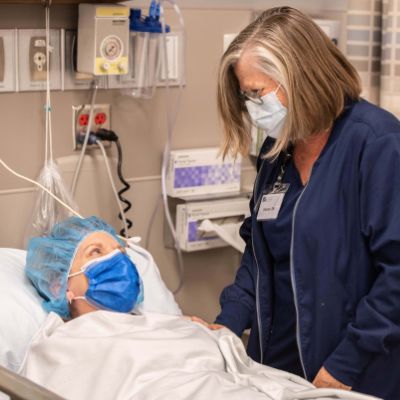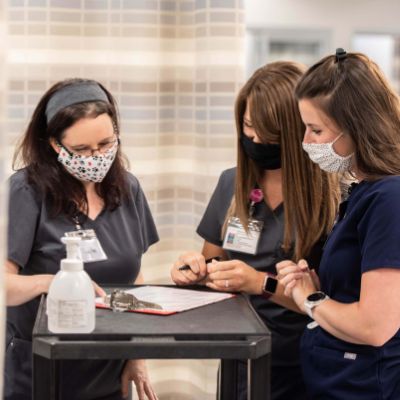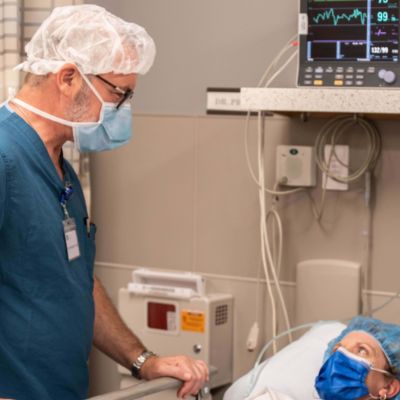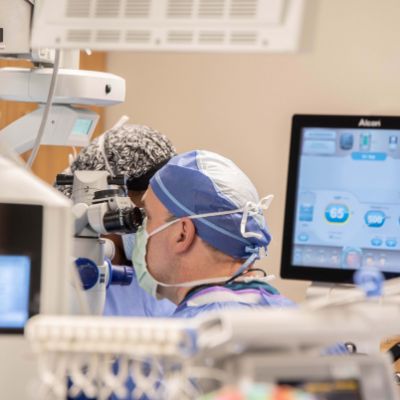Cataracts are the leading cause of blindness in the world, so it’s important to know your options for cataract surgery. Common symptoms such as cloudy vision can seem like a minor inconvenience, however, these symptoms will only become more severe with time if left untreated. Our surgeons are here for you whether you need cataracts removed or any other type of eye surgery in Knoxville.
In this blog we will cover:
- Types of cataract surgery
- The cataract surgery process
- What are cataracts
- What causes cataracts
- Symptoms of cataracts
- Cataract prevention
- The primary types of cataracts
Types of Cataract Surgery
Our surgeons perform over 7,000 cataract eye surgeries per year at Tennessee Valley Eye Center. We offer both traditional cataract surgery and custom cataract surgery.
Traditional Cataract Surgery
Traditional cataract surgery works using a process known as phacoemulsification. For this procedure, a probe is used to direct ultrasonic vibrations into the eye and break up the cataract. Your natural lens is then removed and replaced with a new, artificial one known as an intraocular lens, which provides clearer vision so you can see as you normally would.
Getting rid of your cataracts isn’t the only benefit of surgery. For many patients, a standard monofocal lens can correct issues such as nearsightedness or farsightedness. This allows them to see without corrective eyeglasses or contact lenses. On the other hand, a standard artificial lens may not give you the desired level of visual clarity or correct astigmatism.

Custom Cataract Surgery
Custom cataract surgery works the same way as traditional procedures, removing the affected lens and replacing it with a new one. The main difference is the type of artificial lens that’s used as a replacement. While traditional cataract surgery uses a standard lens, custom procedures use premium lenses that offer more advanced benefits.
Unlike the standard artificial lenses used during cataract surgery, these specialized intraocular lenses are designed to further improve age-related vision changes and astigmatism. With these lenses, you can experience significantly improved vision over standard varieties.
This makes it much easier to:
- Drive
- Read fine print
- Enjoy recreational activities
Our surgeons use ORA technology when performing custom cataract technology. This breakthrough intraoperative tool allows them to provide even more precision than traditional preoperative methods. It provides measurements in real-time during surgery to avoid any refractive issues later on.
Click here to meet our team of eye surgeons in Knoxville!
Cataract Surgery in Knoxville, Tennessee
Knowing what to expect is an important aspect of any eye surgery in Knoxville. It will help you prepare for surgery, feel less anxious about your procedure, and have the best cataract surgery recovery possible. Be sure to talk to your eye surgeon about steps you can take beforehand to ensure that your procedure and recovery go smoothly.
Preparing for Cataract Surgery

You will be asked to fast from food and drink for at least 8 hours before your surgery. Your doctor will also want to know what medications you’re taking since some can raise your risk of bleeding during your procedure. A preadmission nurse will discuss your medical history with you before surgery.
Patients can’t drive after cataract surgery until cleared by the doctor, so you will need to be accompanied by another adult who will drive you home from surgery. You may also be prescribed eye drops before your surgery. Be sure to follow the instructions on the label and from your doctor. They will help ensure that your procedure goes smoothly.
Your eye doctor will schedule imaging studies of your eye before your surgery. This painless procedure measures the shape and size of your eye to determine the size and strength of your new implant. Your doctor will discuss which type is best for your lifestyle and budget.
What to Expect During Cataract Surgery
Cataract surgery is a relatively short procedure that takes an hour or less. Your surgical team will do everything they can to make sure you are as comfortable as possible during that time.
During the procedure, your Knoxville eye doctor will:
- Dilate your pupil with eye drops
- Give you sedating medicine to help you relax
- Apply local anesthetics to numb the area
- Remove the clouded lens
- Apply the new artificial lens
Some patients require cataract surgery for both eyes. In this case, your eye surgeon will wait until the first eye has healed, usually 2 – 4 weeks after the first surgery.
Cataract Surgery Recovery
Most patients experience improved vision after a few days with some blurriness as their eyes adjust. You may notice that colors seem brighter and more clear now that the cataract has been removed. It’s also common to experience some mild discomfort and itching during this time. Just be sure to avoid rubbing your eye or pushing on it while it heals.
Your surgeon will want to see you periodically following your procedure to make sure that everything is healing correctly. Your first visit will be a day or two after surgery with another the following week. Another follow-up will be scheduled for a month after that. The discomfort should disappear a couple of days after your procedure.
You may need to wear an eye patch or protective shield the day of your surgery and for a few days after, including while you sleep. This helps protect your eye from dust and other injuries while it’s healing.
Eye drops may be prescribed to you as an extra precaution. They help prevent:
- Infection
- Inflammation
- Increased eye pressure
In some cases, the medications in these drops are injected into the eye during your surgery. This helps reduce the risk of forgetting to use them, further protecting your eye during the healing process.
How Long Does It Take To Recover From Cataract Surgery?
It takes about eight weeks to completely heal from cataract surgery. It’s important to notify your eye doctor immediately if you notice any major changes in your eyes or vision during this time.
This includes:
- Vision loss
- Persistent pain even with over-the-counter pain relievers
- Increased eye redness
- Swollen eyelids
- Floaters or flashes in your vision
These could be a sign of a complication. Notifying your doctor immediately will allow them to determine the problem and provide the eye care that you need.
Click here to learn more about cataract surgery in East Tennessee!
What Are Cataracts?
A cataract is a clouding of the lens which prevents light from the retina in the back of the eye. This prevents the lens of your eye from being able to focus light the way it normally does, resulting in vision that is distorted and blurry. This clouding gets worse over time, eventually requiring it to be removed and replaced by a new, artificial lens.
A clear lens and unobstructed retina are essential for good vision. When healthy, light is able to freely enter the eye and reach the retina. There, visual information is received, organized, and sent to the brain where it becomes the things that we see. Unfortunately, cataracts prevent this process and require surgical vision care to restore your sight.
What Causes Cataracts?
Cataracts occur when proteins within the lens of the eye begin to break down. This causes the lens to harden and become less flexible. As the proteins break down, they can begin to clump together and cloud your vision. This process can take years to become noticeable, so it’s important to talk to your eye doctor regularly about your eye health.
Cataracts can occur for a number of reasons with aging being the most common. Genetics can also play an important role with some people being more likely to develop the condition than others. In some cases, eye injuries can damage the lens and cause cataracts to develop. Regular eye exams are essential for catching cataracts and getting the treatment you need.

Cataracts occur when proteins within the lens of the eye begin to break down. This causes the lens to harden and become less flexible. As the proteins break down, they can begin to clump together and cloud your vision. This process can take years to become noticeable, so it’s important to talk to your eye doctor regularly about your eye health.
Cataracts can occur for a number of reasons with aging being the most common. Genetics can also play an important role with some people being more likely to develop the condition than others. In some cases, eye injuries can damage the lens and cause cataracts to develop. Regular eye exams are essential for catching cataracts and getting the treatment you need.
Aging
Aging is the most common cause of cataracts. In fact, cataracts are a normal part of getting older, with the breakdown of lens proteins being a natural part of life. This usually starts around the age of 40 with over half of Americans having them by age 80. Cataracts affected around 20 million Americans in 2010, and is projected to affect around 40 million by 2030.
While prevalent, cataracts can go unnoticed for years due to how slowly they develop. They usually start in your 40s, but patients often don’t notice any symptoms until around the age of 60. This is why it’s so important to be proactive when it comes to your eye health. With regular comprehensive eye exams, you can receive treatment for your cataracts sooner than later.
Genetics
Your genetics play a major role in your risk of cataracts. While it’s true that most people will eventually develop them, not everyone will experience them in the same way. For example, you’re at a higher risk of cataracts if your parents or other family members have them. Your eye doctor will want to know this information so they can create a plan for dealing with cataracts.
Take the time to discuss your family medical history with your parents and other relatives. They can alert you to health risks that you may have not been aware of, such as cataracts and diabetes. Be sure to give this information to your eye doctor as well as your other healthcare providers since they can be important indicators of what to expect in your future.
Trauma
The type of cataract you develop from an injury can vary as well as the course of treatment required. Your eye doctor will be able to explain your particular case and treatment options.
Cataracts are one of many reasons why it’s important to see your eye doctor after an eye injury. Your eye care specialist will be able to treat any swelling or other common issues that follow eye trauma. They will also be able to help if you experience more serious problems such as eye floaters or flashes, blurred or double vision, as well as eye mobility issues.
Symptoms of Cataracts

It can be easy to shrug off the symptoms of cataracts in the beginning. However, what seems like only minor problems have actually been developing for years and will only get worse. This is because cataracts grow as more proteins break down, clumping together and affecting your sight. You should contact your eye doctor immediately if you’re experiencing cataract symptoms.
Common cataract symptoms include:
- Blurry or cloudy vision
- Double-vision
- A yellow or brown tint to your vision
- Increased light sensitivity
- Halos around light sources
- Frequent changes to your eye prescription
It can be easy to shrug off some of these symptoms. While they may not seem like a cause for alarm, they can be major signs of cataracts. Not only have these cataracts been growing for years, but their symptoms are only going to worsen. Your eye doctor will need to diagnose the problem so that they can develop a treatment plan for you.
It’s true that cataracts are a natural part of aging and can even be genetic. On the other hand, there are steps you can take to reduce your risk and protect your overall health, as well. While there isn’t a silver bullet to prevent cataracts, following these steps will help protect your vision and provide a healthy life for years to come.
Quit Smoking
You can’t change your genetics or stop aging, but you can make positive lifestyle changes that benefit your vision and overall health. One of the best ways to do this is to quit smoking. As the Center for Disease Control has noted, smokers face a much greater risk of having cataracts than non-smokers. Quitting immediately can help cut your risks significantly.
Always Wear Sun Protection
While sunlight has plenty of benefits, it can also wreak havoc on your eye health. Prolonged sun exposure can actually increase your risk of cataracts or even make them develop more quickly. That’s why you should always wear quality sunglasses and a brimmed hat when you’re going to be spending a lot of time outside.
Maintain Healthy Blood Sugar Levels
Diabetes can have wide-ranging effects on your health, including higher risks of cataracts. According to Diabetes.co.uk, studies have shown that you have a 60% higher risk of cataracts if you are diabetic. Fortunately, those with type 2 diabetes can reduce their risk of cataracts by as much as 19% just by reducing their glucose by 1%.
The Primary Types of Cataracts
Although they develop on the lens of your eye, cataracts can come in different shapes and sizes. They are named for the location on your lens where they develop, which can also affect the symptoms that you experience.
The primary types of cataracts include:
- Nuclear cataracts
- Posterior subcapsular cataracts
- Cortical cataracts

Nuclear Cataracts
These are the most common types of cataracts that eye surgeons treat. Nuclear cataracts are found in the center of your lens, often causing nearsightedness. They can actually be helpful for a time since they can improve your reading vision.
While they may make it easier to see small print and other fine details, nuclear cataracts eventually lead to the clouding of the lens. This affects your ability to see colors clearly as your vision takes on a yellowish or brownish tint.
Posterior Subcapsular Cataracts
Located on the back of the lens, posterior subcapsular cataracts interfere with your vision like other cataracts — clouding and preventing light from reaching the retina. Unlike nuclear cataracts, this type actually makes your near vision worse. They also make it more difficult to see in bright light as well as create halos around lights at night.
Another big difference between posterior subcapsular cataracts and nuclear cataracts is how fast they develop. This type of cataract is much more aggressive than other types and usually develops faster. While other cataracts take years to develop, posterior subcapsular cataracts develop and interfere with your vision much more quickly.
Cortical Cataracts
This type of cataract is located at the edge of the lens. Cortical cataracts begin as triangle-shaped clouds, although they can also appear as streaks at the edge of the lens. They usually affect your vision by stretching toward the middle of your field of view. This way, they gradually prevent light from making it to the retina by working their way toward the center of the lens.
Cortical cataracts are especially common in those with diabetes. They have been associated with higher levels of glycated hemoglobin and pose a risk for as long as you have diabetes. Controlling your blood sugar is especially important for diabetics since it can help prevent this risk as well as other health problems.
Do you have questions about cataract surgery in Knoxville, Tennessee? Contact us today with any questions you may have!
We offer both traditional and custom cataract surgery to restore your sight. Your eye surgeon will guide you as you prepare, undergo, and recover from your procedure. Cataracts are caused by proteins in the lens of the eye breaking down and clumping together. They can occur for a number of reasons with aging being the most common. There are lifestyle changes that you can make that may reduce your risk, such as quitting smoking. Cataracts come in different types with nuclear cataracts being the most common.
Tennessee Valley Eye Center is Knoxville’s premier eye care facility, performing more eye surgeries than any other facility in the region. Our board-certified surgeons cover all ophthalmic subspecialties, including cataracts, cornea, glaucoma, retina, eyelid disorders and cancers, and eye muscle surgeries. We want you to feel as comfortable and confident as possible as you prepare for surgery. If you would like to discuss your surgery with us at any time, please do not hesitate to contact us.


